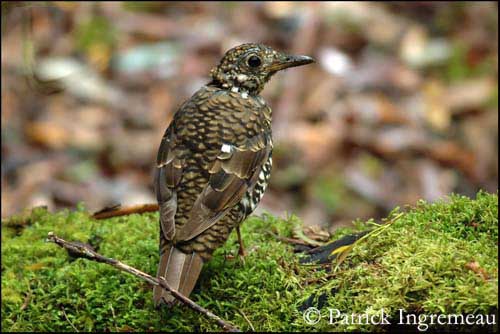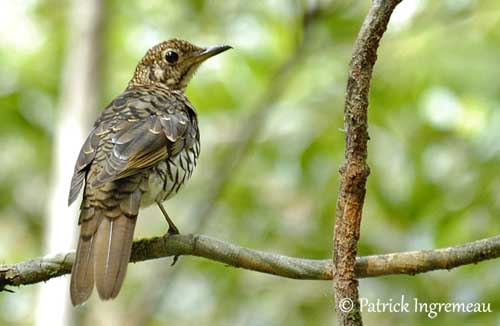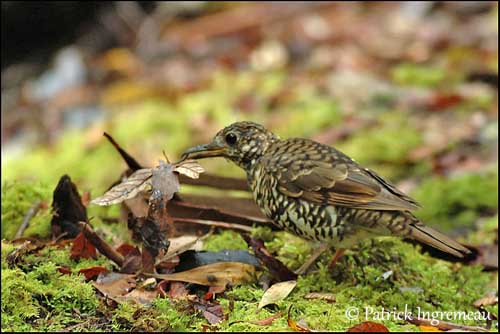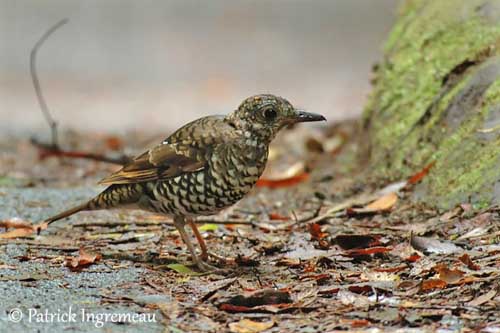
Bassian Thrush
Zoothera lunulata
Passeriforme Order – Turdidae Family
BIOMETRICS:
Length: 27-29 cm
Weight: 90-120 g
DESCRIPTION:
The other common name is Olive-tailed Thrush.
Bassian Thrush has mottled plumage. Upperparts are brown to olive-brown, heavily scalloped with black bars crescent-shaped, on head, back and rump. Tail is dark brown tinged olive, and has 12 feathers.
Underparts are whitish, slightly washed yellowish-buff on breast, sides of lower breast and flanks. Throat, breast, flanks and belly are scalloped with dark brown. Lower belly and vent are whitish. White underwing shows a broad dark diagonal bar.
Head has olive-brown forehead, crown and nape, scalloped with dark crescents. Face is paler, slightly spotted with dark. Chin is whitish.
Bill is blackish with yellow base on lower mandible. Eyes are dark brown, with whitish eye-ring. Legs and feet are pale pinkish-brown.
Both sexes are similar.
Juvenile resembles adult, but with smaller dark crescents on upperparts, and pale-tipped tail feathers. Underparts show rather spots than crescents on breast and belly.
Sometimes considered as subspecies of White’s Thrush (Zoothera dauma), Bassian Thrush has three subspecies: Z.l. cuneata; Z.l. lunulata; Z.l. macrorhyncha. These three subspecies live in different places in Australia and Tasmania.
Fr: Grive à lunules
All : Tasmanerddrossel
Esp : Zorzal Australiano
Ital : Tordo dorato di Bass
Nd : Tasmaanse Goudlijster
Photograph by Patrick Ingremeau
His website : TAMANDUA
Text by Nicole Bouglouan
Sources:
HANDBOOK OF THE BIRDS OF THE WORLD Vol 10 by Josep del Hoyo-Andrew Elliott-David Christie - Lynx Edicions - ISBN: 8487334725
Birds in backyards (Birds Australia and Australian Museum)
Wikipedia (Wikipedia, The Free Encyclopedia)

VOICE: SOUNDS BY XENO-CANTO
Bassian Thrush utters contact call “seep” in flight or when takes off. Alarm call is a sharp “chi-lit”, and some continuous deep trills.
Song is weak, with warbling and trills carrying a short distance. We can also hear fluted two-notes whistle, sometimes continuing as melodious warble. It utters also very soft “hiss” note during the day. Bassian Thrush sings mainly at dusk, during the night and at dawn.
HABITAT:
Bassian Thrush lives in damp, dense forests, from 700 to 1000 metres of elevation. It is also found in humid tropical rainforests and eucalyptus woodlands with underbrush.
During non breeding season, Bassian Thrush may live in open drier areas, secondary forests and large gardens. It can be found in exotic plantations of Pinus radiata.
RANGE:
Bassian Thrush is found mainly around the South-east of Australia, also in the Atherton Tablelands, and in Queensland.

BEHAVIOUR:
Bassian Thrush is mainly sedentary in its range, but it may become nomadic in exceptionally dry years, searching for suitable habitat.
It is usually seen alone or in pairs. Bassian Thrush feeds on the ground, by scratching under leaf-litter for food. This bird is shy and very secretive. It forages in quiet areas, under dense cover. It feeds on invertebrates and worms in fallen leaves and decaying vegetation. It may be seen foraging in forest edges or open areas in grassy clearings. It is mostly crepuscular.
When alarmed or disturbed, Bassian Thrush crouches low, or runs a short distance, or flies rapidly into cover, but it also can remain motionless, avoiding detection by its mottled plumage which provides it good camouflage.

FLIGHT:
Bassian Thrush has fast and direct flight through forests, but when flying across more open areas, it performs undulating and bounding flight with strong wing-beats.
REPRODUCTION:
Bassian Thrush breeds from late June to February.
Nest is often placed in fork in tree or branch, in tree crevice, or in depression on the top of a stump. Nest may be placed low or up, at about 15 metres above the ground.
It is a large bowl-shaped structure, made with bark strips, twigs, stems, grasses and leaves. It is lined with moss, fine grass and rootlets. It also may be covered with moss.
Female lays 2 to 3 pale eggs, green or bluish-green, with fine markings. Incubation lasts about two weeks. Young fledge 14 days after hatching. Both parents share the nest-duties and care for the young.
This species produces two broods per season, and may reuse the same nest for several seasons.
DIET:
Bassian Thrush feeds on insects, earthworms and molluscs, but it also consumes fruits.
PROTECTION / THREATS / STATUS:
Bassian Thrush is affected by clearing of its dense forested habitats for agriculture, and changes in its damp areas.
This species is listened “Near Threatened”.
